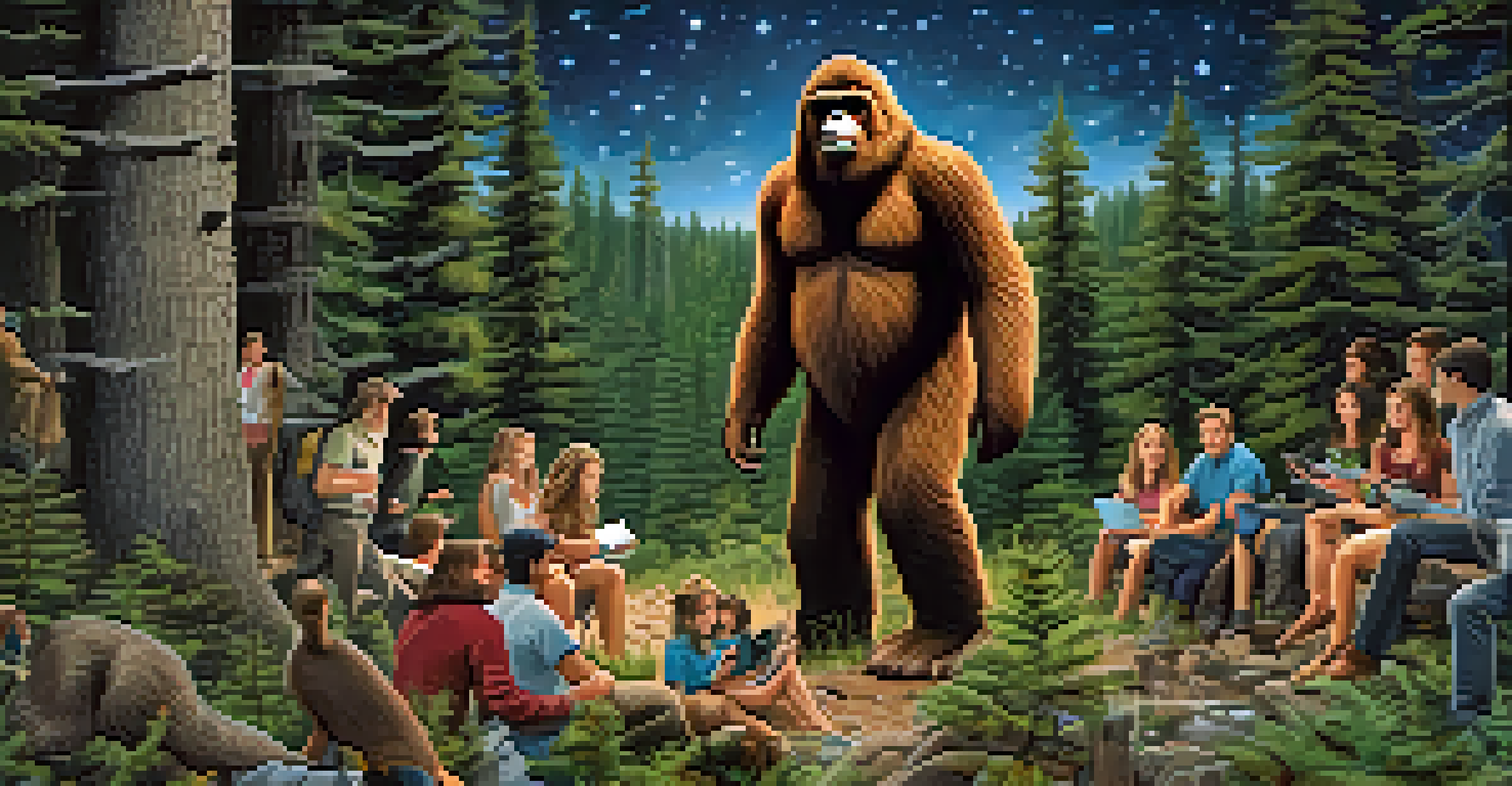Bigfoot Sightings in Dallas: Folklore Meets Reality

The Legend of Bigfoot: A Brief Overview
Bigfoot, often depicted as a large, hairy creature, has captivated imaginations for decades. Originating from various North American folklore, this elusive figure has been part of cultural narratives across many communities. His presence symbolizes the mysteries of nature and the unknown, sparking curiosity and debate among enthusiasts and skeptics alike.
The world is full of magic things, patiently waiting for our senses to grow sharper.
In Texas, stories of Bigfoot sightings date back many years, especially in rural areas where vast forests provide the perfect backdrop for such legends. The tales often describe encounters with a large, bipedal creature, leading to a blend of fear, fascination, and even respect for the unknown. As these stories spread, they have taken on a life of their own, evolving with each retelling.
While many dismiss these accounts as mere myths, others argue that they reflect a deeper connection to nature and the human experience. The legend of Bigfoot is not just about the creature itself; it's about our desire to explore the unexplored and confront our fears, making it a rich topic for storytelling.
Notable Bigfoot Sightings in the Dallas Area
Dallas might be a bustling urban center, but it hasn't been immune to Bigfoot sightings. Reports have emerged from nearby wooded areas, such as the Great Trinity Forest, where residents claim to have encountered the creature. These sightings often describe a large figure moving quickly through the trees, leaving behind perplexing footprints that ignite local curiosity.

One of the most famous sightings occurred in the 1970s, when a group of campers reported an unsettling experience one evening. They described hearing strange noises and seeing shadows moving just beyond the campfire's glow. Though some dismissed their claims as mere paranoia, the story has since become a staple in local folklore, fueling further interest in the Dallas Bigfoot narrative.
Bigfoot's Cultural Significance
The legend of Bigfoot reflects our fascination with the unknown and our desire to explore nature.
These sightings continue to spark discussions among enthusiasts and researchers alike. Whether they are true encounters or simply figments of imagination, they add to the rich tapestry of Dallas's cultural lore, reminding us that the unexplained can often be as fascinating as the tangible.
The Role of Social Media in Bigfoot Discussions
In today's digital age, social media plays a significant role in shaping the narrative around Bigfoot sightings. Platforms like Facebook and Twitter allow enthusiasts to share their experiences, photos, and theories instantly, creating a vibrant community passionate about the subject. This accessibility helps keep the legends alive and encourages more people to explore the possibility of Bigfoot's existence.
There are more things in heaven and earth, Horatio, than are dreamt of in your philosophy.
Recent posts from Dallas residents have gone viral, showcasing alleged sightings and strange noises recorded in the woods. These online discussions often lead to heated debates between believers and skeptics, further fueling interest in the topic. The power of social media means that a single sighting can reach thousands, igniting conversations and reigniting curiosity about this mythical creature.
Moreover, social media has also led to the organization of local meet-ups and expeditions, where enthusiasts gather to share stories and search for evidence. This community aspect fosters connections among those who share a common interest, transforming folklore into a collaborative exploration of the unknown.
Skepticism vs. Belief: The Bigfoot Debate
The debate surrounding Bigfoot sightings often pits skeptics against believers, creating a dynamic discourse. Skeptics argue that many sightings can be attributed to hoaxes, misidentifications, or even the influence of alcohol and fatigue on witnesses. They emphasize the lack of tangible evidence, such as clear photographs or physical remains, to support claims of Bigfoot's existence.
On the other hand, believers point to the sheer volume of sightings and anecdotal evidence as a compelling argument for the creature's reality. They often cite the vast, unexplored wilderness of North America as a viable habitat for a creature that remains elusive. This passionate belief is rooted in a sense of wonder and the idea that not everything in our world can be easily explained.
Skepticism Surrounds Bigfoot Claims
The ongoing debate between skeptics and believers highlights the complexity of the Bigfoot phenomenon.
Ultimately, this ongoing debate adds richness to the Bigfoot legend. It encourages critical thinking and open-mindedness while also fostering a sense of community among those who seek to understand the mysteries of our world.
Bigfoot in Popular Culture: Movies and Media
Bigfoot has made a lasting impact on popular culture, featuring in numerous movies, TV shows, and documentaries. From classic films like 'Harry and the Hendersons' to modern series exploring cryptids, the mythos of Bigfoot continues to capture the public's imagination. These representations often blend humor with intrigue, making the creature accessible to broader audiences.
In recent years, reality TV shows have further popularized Bigfoot hunting expeditions, showcasing teams of enthusiasts searching for evidence. These programs often dramatize encounters, leading to both fascination and skepticism. While some viewers enjoy the thrill of the chase, others question the authenticity of the findings presented on screen.
By weaving Bigfoot into various forms of entertainment, creators contribute to the ongoing legend. This cultural significance keeps the conversation alive, inviting new generations to explore the stories and perhaps even venture into the woods with hopes of catching a glimpse of the legendary creature.
The Scientific Perspective on Bigfoot
The scientific community has largely approached the Bigfoot phenomenon with skepticism. Many researchers emphasize the need for empirical evidence, such as DNA samples or verified physical remains, to substantiate claims of the creature's existence. Without concrete proof, the majority of scientists regard Bigfoot as a myth rather than a biological reality.
Despite this skepticism, some scientists and researchers have dedicated their efforts to studying the phenomenon. They analyze reported sightings, footprint casts, and audio recordings to determine if there's any merit to the claims. This intersection of folklore and science creates an intriguing dialogue, as researchers navigate the fine line between belief and empirical validation.
Social Media Fuels Bigfoot Interest
Social media platforms have transformed how Bigfoot sightings are shared and discussed, creating a vibrant community.
While mainstream science may not endorse the existence of Bigfoot, it acknowledges the cultural significance of such legends. The pursuit of understanding human beliefs and the stories we tell can be just as valuable as proving or disproving the existence of a creature like Bigfoot.
The Future of Bigfoot Sightings in Dallas
As technology advances, the future of Bigfoot sightings may evolve along with it. With the rise of smartphones and high-quality cameras, the chances of capturing clear evidence of the creature have increased significantly. Additionally, advancements in sound recording technology could help enthusiasts document unusual noises in the woods more effectively.
Moreover, as urban areas expand, interactions between humans and wildlife may become more common. This could lead to more sightings and encounters, as the boundaries between nature and urban life blur. The ongoing fascination with Bigfoot ensures that stories will continue to emerge, keeping the legend alive.

Ultimately, whether Bigfoot is real or just a figment of our imagination, the stories and sightings contribute to a rich cultural tapestry. Dallas, with its unique blend of urban life and natural spaces, will likely continue to be a hotspot for these intriguing tales, inviting both believers and skeptics to explore the mysteries of the unknown.